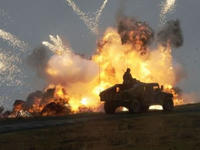-
Shaken lawmakers weigh additional security measures

Following the shooting of Representative Gabrielle Giffords (D-Arizona), more than 800 participants — members of Congress, their spouses, and staffs — take part in a conference call Sunday; the FBI, House Sergeant at Arms Bill Livingood, and U.S. Capitol Police Chief Phil Morse detailed security measures lawmakers and their family members should take both in Washington, D.C. and in their home districts; another security briefing for lawmakers is scheduled for Wednesday; the last time a member of Congress was shot and killed was in 1978, when Representative Leo Ryan (D-California) tried to leave Jonestown, Guyana, with members of Jim Jones’s cult; six members of Congress have been murdered as well as two senators — Huey Long in 1935 and Robert Kennedy in 1968; five members of Congress were injured when Puerto Rican nationalists shot up the House chamber on 21 March 1954
-
-
Suspected Arizona gunman passed FBI background check
The alleged shooter of Representative Giffords and eighteen other people in Arizona purchased a firearm legally — and after passing an FBI background check — from Sportsman’s Warehouse’s Tucson store in November; Loughner did not present a concealed weapons permit so he was required to pass an FBI background check, which he did “immediately and without incident,” the company which owns the store says; a DHS memo ties Loughner to the extremist group American Renaissance, which DHS describes as “anti-government, anti-immigration, anti-ZOG (Zionist Occupational Government), anti-Semitic”; the group leader says Loughner had no connection with his group
-
-
New laser weapon dazzles, confuses pirates
There were 430 pirate attacks last year, an increase of 5.6 percent on the previous year; in a bid to develop a suitable non-lethal weapon to help fend off this threat, BAE Systems studied pirate behavior; the conclusion was that an automatic weapon was needed, one that would not put any of the crew at risk, and one which would distract suspected pirates rather than harm them
-
-
Portable device helps officers ID uncooperative suspects
A portable fingerprint scanner helps police in a Florida town to identify people who refuse to identify themselves; the portable device searches the database of the Florida Department of Law Enforcement, which has more than 5.5 million criminal records; it also crosschecks a FBI database of wanted persons, sex offender registry and known or suspected terrorists
-
-
Mobile phone forensic tools to reduce hi-tech crimes
Government funded technology center in India is developing a set of mobile forensic tools that will assist the law enforcement agencies in cracking unlawful activities committed using mobile phones; the center is a government agency, and will be able to provide the tools at reasonable cost
-
-
Measuring carbon monoxide levels in bloodstream at the scene
Carbon monoxide is a colorless, odorless, tasteless, and nonirritating toxic gas that can cause severe health problems or even death; communities in western Massachusetts use DHS grants to buy specialized devices that can quickly measure the level of carbon monoxide in a person’s bloodstream at a fire scene
-
-
Increasing counter-IED role for robots
U.S. and coalition military operating in Afghanistan have experienced about 10,500 roadside bomb incidents so far this year, up from 8,994 in 2009 and 2,677 in 2007; robots continue to play ever-more important combat roles in the air and on the ground in Afghanistan and Iraq, and their responsibilities will only continue to grow
-
-
Pentagon: dogs better than technology at bomb detection
The most sophisticated detectors the Pentagon came up with tend to locate only 50 percent of IEDs in Afghanistan and Iraq; when soldiers are accompanied by bomb-sniffing dogs, this number goes up to 80 percent; the Pentagon now spends less money on IED detection and more money on drones to find those planting IEDs, radio jammers to disrupt the frequencies used to detonate the bombs, and lots of aerial sensors to scan bomb-heavy areas
-
-
Huge jump in IED attacks in Afghanistan

Monthly IED “incidents” in Afghanistan — incidents are defined as IEDs placed by insurgents and either found or detonated — from January 2004 to April 2010 has risen dramatically; data shows that an astounding jump in IED incidents occurred beginning summer 2009 — coinciding with the Marine offensive in the Helmand River Valley — and IED attacks have steadily mounted; there were more than 1,000 IED incidents during March, April, and May of this year; one expert says: data shows “that IEDs have become the equivalent of the Stinger [during the mujahedin war against the USSR in the 1980s] in allowing irregular forces to pose a major threat even to the most advanced military forces in the world”
-
-
Senate panel rejects Pentagon counter-IED group $400 million emergency funding request
Senate panel denies Pentagon’s counter-IED group a $400 million emergency request; lawmakers say that counter-IED organization has misused funds allocated to it — among other things, to hire private contractors in Iraq to hunt down insurgents; senators also criticized the group for planning to use emergency funds to fund long term projects such as airships and UAV radar
-
-
Awareness card for vehicle-borne IEDs
First responders may now download a card which will help them identify — and respond to — IEDs and other suspected explosives
-
-
Safer ride: Lockheed ,A-V deliver vehicle-mounted anti-IED devices
IEDs kill more U.S. and coalition soldiers in Iraq and Afghanistan than any other weapon used by militants; Lockheed Martin received a $940 million contract to produce a counter-IED jamming device, and the first of these vehicle-mounted systems are being delivered to the theater.
-
-
Market for counter-IED technologies growing
Improvised explosive devices (IEDs) are a significant threat in many conflict zones, most notably in Afghanistan and Iraq; the United States has spent billions of dollars on IED countermeasures, but still IEDs are a number one threat to U.S. military personnel in the theater; there is a large market for IED countermeasures and defense, with leading and developing countries worldwide investing steadily in those products
-
- « first
- ‹ previous
- 1
- 2
- 3
